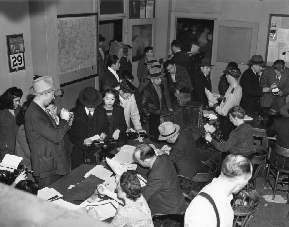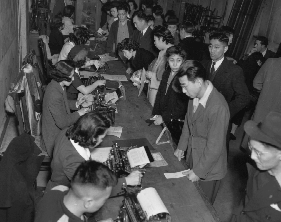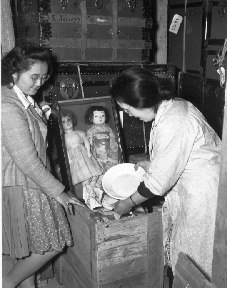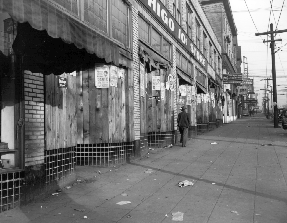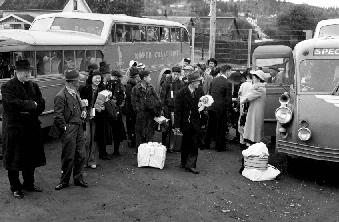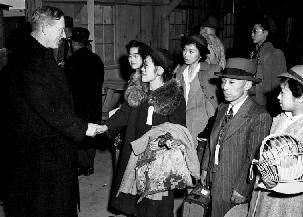Round-Up to the Camp
At the end of April 1942, the first of Seattle's Japanese community was shipped off to Puyallup. The move was facilitated by the Emergency Defense Council of the Japanese American Citizens League. The council worked closely with the military authorities to register and transport the evacuees.
There was a military precision to the maneuver complete with timetables, contingency plans and mandated routes. Within a week the more than 2,500 Japanese Americans of Seattle had been transported to Puyallup. The once bustling streets of Chinatown were filled with boarded up stores, hotels and businesses.
By the end of May more than 7,000 people were living in Camp Harmony. They had primarily come from Seattle and its surrounding communities, including approximately 1,200 people from the Tacoma area, with a small contingent from Alaska. They were to stay in Puyallup for four months until being shipped out to the Minidoka Relocation Center, in southern Idaho, in late August.
|
Seattle Post-Intelligencer Collection. PI-28030. Museum of History and Industry, Seattle, Washington. |
|
|
"Pick Advance Guard for Puyallup Camp." Japanese American Courier, April 24, 1942, page 4. |
Plans for evacuating 2,000 Seattle Japanese from two areas by next week speeded up this week, when a high Army officer set up headquarters at the offices of the Japanese American Citizens League, 517 Main Street, and established a working agreement with local Japanese leaders. Registration will be conducted tomorrow and Sunday, and the movement will start Tuesday. An advance staff of young Americans of Japanese ancestry has been selected to prepare for reception at Camp Harmony, as it has been designated. It is estimated there will be about 100 of these. There are information supervisors, publicity officers, mess officers, foremen and various other executives for each subdivision. These were chosen at a conference which Army officers held with leaders of the Emergency Defense Council of the Seattle chapter of the Japanese American Citizens League--James Y. Sakamoto, general chairman; William Hosokawa, secretary; Richard Setsuda, fiscal agent; George Ishihara, civil protection chairman; Tom Kanno, welfare corps and William Y. Mimbu. |
|
March Serial No. 2 April 30. Emergency Defense Council of the Seattle Chapter, Japanese American Citizens' League. Box 18. Manuscripts and University Archives, UW Libraries. |
Pursuant to the provisions of Civilian Exclusion Orders No. 17 and 18, Headquarters Western Defense Command and Fourth Army, and further in accordance with directives pertaining thereto, March Serial No. 2, consisting of approximately 850 Japanese residing in both excluded areas will proceed by motor march to the Puyallup Assembly Area. Families will be kept intact for the movement. Japanese evacuees may use their own privately-owned motor vehicles for the movement, with the understanding that such automobiles will be impounded at the Assembly Center. All private automobiles so used will first have been registered with the representative of the Federal Reserve Bank at the Services and Control Station. Transportation for the balance of March Serial No. 2 will be furnished by the United States Army. |
|
Japanese Evacuation Report #11. Written by Joseph Conard of the Seattle Office of the American Friends Service Committee dated May 11, 1942. Joseph Conard, Collector, Box 4. Hoover Institution Archives. |
The Japanese on both occasions were their cheerful selves: stoicism is a wonderful thing, for circumstances like these. Think what these people have been doing: the past week standing in line, first to register, then for physical exams. The last frantic arrangements, selling, storing, dispensing with precious possessions, leaving pets and gardens behind, then the last night, most of them up until 4 and 5 AM packing, getting everything ready for the early morning departure, everything neatly labeled and properly boxed. Then for a few hours sleep on the hard floors in a home empty of furniture, no beds or mattresses; those sold or stored. Then at 6 or so up and get the children ready, dress in your best clothes, come down in the puring [sic] rain of a cold dreary day, stand in line and mill around in the confusion of departure for an hour and a half, then load into buses and at last we're off. |
|
Seattle Post-Intelligencer Collection. PI-28034. Museum of History and Industry, Seattle, Washington. |
|
|
Life in Camp Harmony. In Nisei Daughter, Seattle: University of Washington Press. |
On the twenty-first of April, a Tuesday, the general gave us the shattering news. "All the Seattle Japanese will be moved to Puyallup by May 1. Everyone must be registered Saturday and Sunday between 8 A.M. and 5 P.M. They will leave next week in three groups, on Tuesday, Thursday and Friday." Up to that moment, we had hoped against hope that something or someone would intervene for us. Now there was no time for moaning. A thousand and one details must be attended to in this one week of grace. Those seven days sputtered out like matches struck in the wind, as we rushed wildly about. Mother distributed sheets, pillowcases and blankets, which we stuffed into seabags. Into the two suitcases, we packed heavy winter overcoats, plenty of sweaters, woolen slacks and skirts, flannel pajamas and scarves. Personal toilet articles, one tin plate, tin cup and silverware completed our luggage. The one seabag and two suitcases apiece were going to be the backbone of our future home, and we planned it carefully. Henry went to the Control Station to register the family. He came home with twenty tags, all numbered "10710," tags to be attached to each piece of baggage, and one to hang from our coat lapels. From then on, we were known as Family #10710. |
|
Seattle Post-Intelligencer Collection. PI-28064. Museum of History and Industry, Seattle, Washington. |
|
|
"Jap Invasion of Puyallup Under Way." Puyallup Press, May 11, 1942, pg. 1. |
The Japanese invasion of Puyallup is under way. Today's arrivals will bring the invasion army up to a figure of nearly 2,000 and reinforcements are moving in daily. The invasion army moved in on wheels, not tanks or motorized lorries but in more prosaic moving vans, busses and private automobiles. Camp Harmony on the Fair Grounds was the objective and two columns bore down on it, one coming from Alaska and the other from Seattle. They did not take Camp Harmony, it took them. The Japanese evacuees have named the assembly center "Camp Harmony" but the townspeople prefer to call it simply "Little Tokyo." Buildings for the center were erected by the army in less than three weeks. |
|
Photograph by Tacoma News Tribune photographer, Howard Clifford. UW538, Special Collections and Preservation Division, University of Washington Libraries. |
|
|
"City's Jap Evacuees Start 'Housekeeping' in Puyallup." Seattle Times, April 28, 1942, pg. 5. |
At 8 o'clock this morning the Seattle evacuees began to arrive at three pick-up points previously designated, taking with them those necessities which the Army had advised them to carry. These included blankets, linen, silverware and dishes, extra clothing and personal necessities such as tooth brushes and razors' Many friends, who will be evacuated later in the week , were on hand to bid the first contingent good-bye. Members of the crowd were in good spirits. There was laughing and shouting and cheerful farewells. Children were in a picnic mood and the departure was like the start of an excursion party. |
|
Photograph by Tacoma News Tribune photographer, Howard Clifford. UW562, Special Collections and Preservation Division, University of Washington Libraries. |
|
|
Telegram from Seattle Mayor, Earl Millikin to Congressman John H. Tolan dated April 27, 1942. In American concentration camps: a documentary history of the relocation and incarceration of Japanese Americans, 1942-1945. New York: Garland, 1989. |
Seattle, Wash., April 27, 1942 Hon. John H. Tolan Disposition of Japanese property in Seattle going well. Office for Emergency Management and Federal Reserve bank have done excellent job. No demolition in prospect. Some Japanese stores have been liquidated, some sold outright and some leased. First two zones to be evacuated this week do not touch heart of Japanese district. Evacuation thus far very quiet and orderly. No other official comment deemed necessary. Earl Millikin, Mayor of Seattle. |
|
Letter to the Tolan Committee from T. Nakamura received March 4, 1942. National Defense Migration, Fourth Interim Report of the Select Committee Investigating National Defense Migration. 77th Congress, 2nd Session, House Report No. 2124. May 1942. In American concentration camps: a documentary history of the relocation and incarceration of Japanese Americans, 1942-1945. New York: Garland, 1989. |
For Sale or Rent At Poulsbo, Wash., Kitsap County: Truck and all equipment for operation of this business. Principal crops, tomatoes and cucumbers in spring and summer; and chrysanthemums in fall and winter. Potted plants. Tomatoes and cucumbers are now planted and cared for, and everything ready for some experienced and responsible party to carry on. Estimated income from this crop coming in, $5,000. From chrysanthemums, $2,000. A new residence, seven rooms, now under construction, will be finished and ready to move into this month. Also small four-room residence on this property. No encumbrances. |
|
Seattle Post-Intelligencer Collection. Jackson Street block showing vacant stores after evacuation. Museum of History and Industry, Seattle, Washington. |
